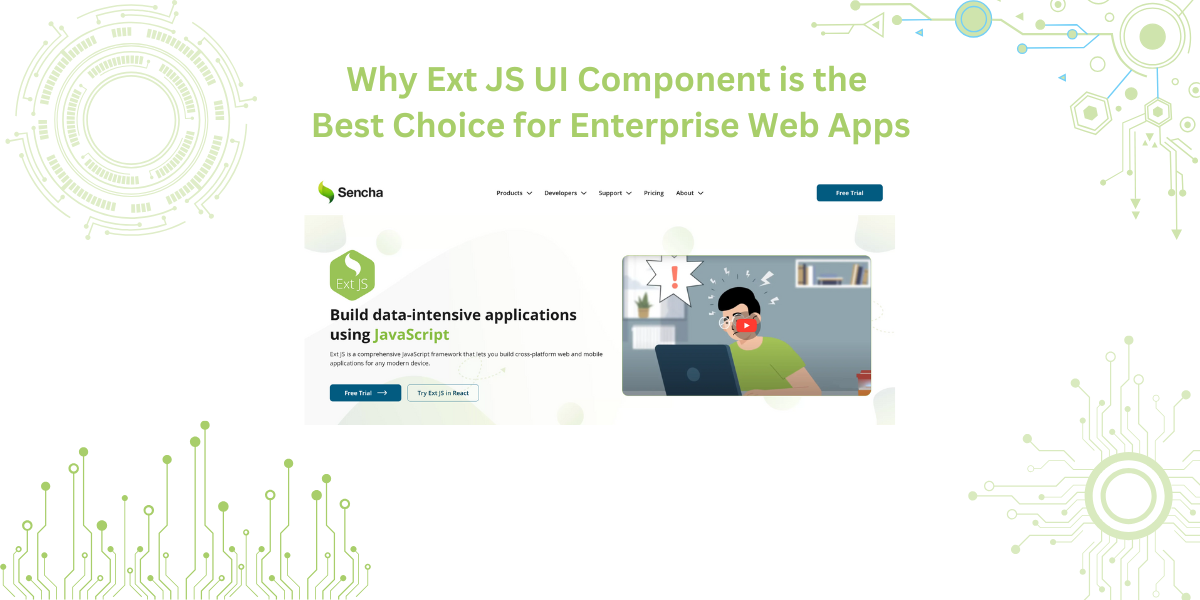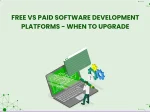Why Ext JS UI Component is the Best Choice for Enterprise Web Apps
All businesses must develop dynamic web applications in this rapidly evolving technical environment. From heavy operations to user-friendly interfaces, enterprise level web applications must fulfil standards of performance, reliability, and usability. One of the best tools used in this regard is Ext JS, a powerful application development software trusted by many developers.

This blog explores why Ext JS UI components are considered the most recommended web app protection for enterprise-level security and performance. We’ll also highlight how Ext JS accelerates enterprise application development services and supports the creation of rapid web apps with sophisticated interfaces and robust backend logic.
Ext JS Overview
Ext JS is based on JavaScript and is a comprehensive web application framework, used for building enterprise-level web applications. It is a priority choice in industry for enterprise business application development as it offers architectural patterns such as MVC(Model-View-Controller) along with an extensive library for UI components. Ext JS UI Components offer enterprise-grade robustness, customizability, and cross-browser compatibility, enabling developers to build scalable, data-driven, and secure web applications efficiently while streamlining API integration ui components.
When compared to other platforms for web and application development, Ext JS goes beyond just UI. It integrates enterprise application platform capabilities, including state management, data handling, and performance optimisation.
If you’ve been wondering what a web based application is or the difference between a web application and a website, Ext JS is a great place to start understanding enterprise-level development. A web application is dynamic and complex, often requiring real time analysis and updates, whereas a website provides static information.
Ext JS is the ideal framework for organisations that need to manage massive data, real-time updates, and a large number of users on their applications.
Key Features of Ext JS UI Components
Robustness
Ext JS UI components are known for their robustness, making them a good choice when building enterprise level business applications or single page dashboards. The components can handle complex updates that an enterprise level application demands, along with visually appealing interfaces.
Customizability
What truly sets Ext JS apart is its customizability. Developers can customise how each piece of the interface looks and how it behaves. This level of customizability provides the developers and businesses with ease, where every business has its own features and modules to implement.
Multi-Browser Compatibility
Compatibility across multiple browsers is considered one of the key features when building an application. It’s not just a nice-to-have – it’s essential in enterprise web app development. You never know what browser your end users might be working with, especially when your application is used across various departments or shared with external partners.
That’s where Ext JS is really needed. It makes sure your web app works the same way no matter which browser someone’s using – whether it’s Chrome, Firefox, Safari, or even old Internet Explorer. This kind of cross-browser support is super helpful. It saves you from unexpected bugs or weird layout issues that might confuse or frustrate users.
Even minor differences across browsers might cause confusion, support overload, or lower productivity in large-scale enterprise application platforms. Ext JS eliminates that difficulty right away, which is why it’s such a great option.
So whether you’re working on single-page web applications or aiming to create web application tools for distributed teams, Ext JS delivers a consistent experience across the board. It keeps your enterprise business applications polished and reliable, which means fewer disruptions, better collaboration, and happier users across every browser.
Data-Driven Components
Being able to handle large amounts of data sets is a key aspect in enterprise applications. With its high-performance data grids, charts, and tree views, Ext JS facilitates this. These data-driven elements easily integrate with back-end systems and are made for real-time interactions.
Ext JS components manage any visual interface, including dashboards and reports, with ease. For developers working on web and application development projects, these ready-to-integrate data tools significantly reduce the effort and complexity of managing enterprise-scale information.
Scalability and Performance
Performance
Ext JS is designed with performance at its core, which is a key feature when building business applications for enterprises. Even when dealing with large datasets, the framework handles tasks like sorting, filtering, and rendering with efficiency and smoothness.
Performance optimisation to this level supports enterprise application services by ensuring smooth performance and satisfaction of end users, two key benchmarks in any successful web-based application.
Scalability
Enterprise apps need to be scalable to provide any additional features whenever necessary. Whether you’re starting with a small internal system or rolling out a full-featured enterprise app store, Ext JS adapts easily to the requirements. Its scalable MVC architecture gives your development team the structure they need to build reliable, maintainable applications.
With the increase in demand, project teams can scale the applications without restructuring everything. This adaptability makes Ext JS a smart choice for enterprise application platforms.
Security and Compliance
In today’s digital world, all business applications, from small to large, require high security. Ext JS comes with built-in protection against stuff like Cross-Site Scripting (XSS) and Cross-Site Request Forgery (CSRF), so you don’t have to set all that up from zero.
Plus, it handles things like authentication and user access rules pretty well. That means it’s easier to keep your app secure, and users only see what they should. This makes Ext JS the most recommended web app protection for enterprise-level security.
With increasing data privacy regulations, having such strong security features baked into your enterprise application software is no longer optional; it’s essential.
Developer Productivity
Development Speed and Simplicity
Time is really important, especially for enterprises with business development. With Ext JS,developers get the maximum use of their time and use the templates and codebases provided. Its extensive UI component library lets teams create web applications easily and quickly, without having to compromise quality.
Ext JS makes the entire process as smooth as possible, from reusable templates to structured codebases. Project teams can move from planning to deployment quickly, which is significant in business environments.
Tools and Support
Ext JS is an ecosystem. Ext JS comes with its own handy toolkit to make life easier. You’ve got Sencha Architect, Sencha Cmd, and Sencha Test – kind of an all-in-one setup. These tools speed things up, from the very first planning steps to running tests before launch. If you’re working with Ext JS, they really help smooth out the whole process.
Plus, with access to extensive support services and documentation, the teams that are new to business development can even get started within no time. Whether you’re learning how to build a web application for the first time or improving an existing system, Ext JS makes the process easier at every step, especially when navigating key differences like web application vs website during development.
Examples of Real-World Use
Ext JS drives a wide range of enterprise business applications, including internal analytics dashboards and CRM systems.
Many organisations opt for Ext JS because it supports both internal tools and customer-facing portals with the same efficiency and security. Whether you’re building HR platforms or logistics tracking systems, Ext JS is the backbone you need.
Application Server vs. Web Server
While a web server answers HTTP requests and delivers static content (such as HTML and CSS), an application server handles business logic and dynamic content. In an enterprise business setting, both are usually used in tandem with Ext JS apps.
Enterprise Application Development: What Is It?
It’s about creating something strong and reliable that keeps up with the company’s needs without falling apart under pressure. These apps should make it easier for teams to make decisions, run smoothly across different departments, and fit in nicely with whatever systems the company’s already using. Plus, they need to grow with the business and stay reliable under pressure. Ext JS excels in this situation. By offering a large selection of pre-built tools, user interface elements, and compliance-supporting capabilities, it provides a strong foundation for developing enterprise application software.
Ext JS makes development quicker, easier, and scalable—ideal for any enterprise application platform, whether you’re managing enterprise business apps or releasing a new solution via an enterprise app store.
Ready for the Future
The world of digital enterprises is rapidly evolving. Web-based applications are being used by the majority of enterprises in order to grow effectively, reduce expenses, and maintain agility. Tools like Ext JS are quite useful because of this.
Think of Ext JS as a solid foundation for enterprise web app development. With integrated components, robust security features, and an easily maintained structure, it simplifies the task. Teams adore how Ext JS eliminates uncertainty. They can concentrate on resolving actual business issues rather than creating grids, forms, and charts from scratch. This translates into better code, fewer problems, and quicker rollouts. It’s a perfectly engineered contrast to the trial-and-error that can happen with other platforms.
Whether you’re working on single page web applications or expanding into public-facing tools via your enterprise app store, Ext JS keeps everything cohesive. It delivers mobile responsiveness and supports accessibility standards, so everyone gets a consistent, polished experience.
In short, Ext JS offers the performance and adaptability modern businesses need. It’s the kind of enterprise application platform that developers—and stakeholders—can trust.
Tailwind CSS and Accessibility
TailwindCSS and Ext JS actually work pretty well together. They help developers follow accessibility standards without too much hassle. So if you’re working on a government app or just want to make sure your UI is ADA-compliant, using both makes the job easier. You can build flexible, useful components without starting everything from scratch
Conclusion
Ext JS is the leading framework when we talk about enterprise level web application development. It supports everything from the public-facing apps you may offer in your enterprise app store to the internal tools your staff uses on a daily basis.
Ext JS helps you build web application projects that are safe, adaptable, and ready to expand, whether you’re building a fast web application for instant deployment or scaling up a feature-rich business application platform. For businesses that offer corporate application development services and wish to keep up with the rapid advancements in technology, it’s a wise decision.
From small-scale solutions to large-scale enterprise business apps, teams can create anything with this robust web application framework. By making difficult operations simpler, developers may devote more effort to addressing actual business problems rather than juggling backend complexities. Ext JS handles the grunt work, keeping your enterprise application streamlined and user-focused while improving speed and making sure your apps are accessible and mobile-friendly.
Furthermore, Ext JS unmistakably benefits from dynamic, data-driven apps that adapt to your demands when comparing online applications and websites. Whether you’re working with a web server vs application server setup or handling both, Ext JS fits right in. It’s everything you need to build enterprise-level apps that last.
Create awesome apps today using our efficient framework.
FAQs
What is the creation of web applications?
It involves creating dynamic programs that function flawlessly on web browsers. These programs process user input, establish a connection with databases, and then reply to users.
What is a web based application?
Web servers host web-based applications, which are accessed by web browsers. Email services, organisational dashboards, and online banking systems are a few instances of web-based apps.
How to build a web application?
Quickstart by choosing a framework (like Ext JS) or tech stack, define all the features, design the UI elements , implement and integrate backend logic, and do testing and deployment. Using a framework like Ext JS simplifies and helps in the easy creation of web applications.
How to develop web applications?
Development requires tools like databases, APIs, frontend (HTML, CSS, JavaScript), and backend (logic-building). Designing and creating dynamic applications is made simpler for developers by frameworks like Ext JS.
An enterprise application: what is it?
Large-scale software created to function in a corporate setting is known as an enterprise application. It facilitates the automation and management of commercial operations, including customer relations, human resources, and finance.
What is enterprise application software?
Enterprise application software is the software that runs enterprise-level processes. This software includes CRM systems, ERP tools, and business analytics platforms.
What is enterprise application development?
A process of crafting and developing applications that are specifically oriented to the organisation’s or business’s needs. This involves secure coding, data handling, and compliance.
What are web based applications?
Web servers host web-based applications, which are accessed by web browsers. Email services, organisational dashboards, and online banking systems are a few instances of web-based apps.
What Are Web Applications’ Drawbacks?
Even though web and application development have advanced significantly, web apps still have some limitations. They may occasionally perform worse than native programs, require a constant internet connection, and present security issues if development isn’t done properly. Investing in the best web app protection for enterprise-level security is essential while creating enterprise application software.
What Is a Progressive Web Application?
The best features of mobile and web are combined in a progressive web application (PWA). It is built using web technologies but gives a native app experience to users. It is a good choice for teams to integrate multiple single page sites or have developers develop applications with native-like experiences with ease.

The selection of a front end framework for enterprise applications remains one of the most…

Every software project begins with a choice that reverberates through its entire lifecycle: which development…

Building software for regulated industries demands more than functional code. Healthcare organizations must protect patient…









